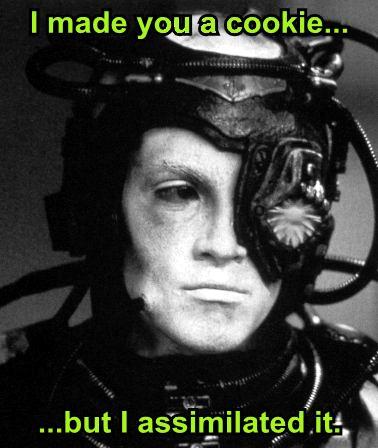Lesson 8: Early Cognitive Development: Genetic Epistemology
Attention

The kind of Assimilation talked about in Star Trek by the Borg is NOT the same as the kind of Assimilation that we do every day when we learn!
(If you have no idea what I'm talking about...click HERE)
Learning Outcomes
Upon completion of this lesson's material, students will be able to:
- Identify and apply the basic processes of assimilation and accommodation to the process of learning
- Compare and contrast the first two stages of Piaget's Genetic Epistemology
Teaching
Basics of Cognitive Development
- Assimilation--when new experiences are readily incorporated into existing schemes
- Accommodation--when schemes are modified based on experience
A Story...
Traveling along the road with my daughter I passed a farm on the right. On the hill behind the fence was a cow. My daughter pointed to it and said..."What is that?" I replied, "That is a cow!" She was content with that having repeated the word several times. (She assimilated that into her schemes of animals and "things you see while in the car").
A few miles later we came across another farm. Behind the fence was a horse. My daughter pointed to the animal and said excitedly, "Cow!" (My daughter had generalized the characteristics of the cow she had already seen to a very similar experience of the horse.) I corrected her and said that this was a horse and explained why they were different. (At this point my daughter is engaged in assimilating the new information about "horse" and accommodating, or modifying, her schema about "cow")
Piaget

Piaget developed a stage theory to describe the qualitative changes in thinking that occur in children.
- Sensorimotor Thinking
- Adapting to and exploring the environment
- Understanding objects (the development of object permanence---understanding that things continue to exist even when we can't see them)
- Using Symbols (language, signs, signals, etc.)
(Click HERE to visit this video on YouTube directly)
In this video you can see a very young child displaying some characteristics of the development of object permanence
- Preoperational Thinking
- Egocentrism--difficulty in seeing the world from other's perspective
- Centration--narrowly focused thought
- Appearance as Reality
- Conservation
(Click HERE to visit this video on YouTube directly)
This video provides a good portrayal of a classic Piaget experiment for Egocentric thought
Piaget and Conservation
Click HERE to review a document outlining the basic premise of Piaget's Conservation theory and a great link to an online source on Piaget in general.
Naive Physics and Naive Biology
It seems that children are born with a basic understanding of the world in terms of physical objects and how they interact and in terms of basic biology.
Children are surprised when they encounter experiences that seem to violate these expectations.
- Naive Biology
- Movement---animals move themselves while objects can be moved
- Growth---animals get bigger and more complex and inanimate objects stay the same
- Internal Parts---inside animate objects contain different materials than the insides of inanimate objects
- Inheritance---the recognize that offspring resemble their parents
- Illness---realize that some conditions such as food allergies are inherited while other illnesses are acquired (such as a cold)
- Healing---realize that when damaged animate objects heal themselves while inanimate objects need to be fixed by humans
Assessment
Lesson 8 Discussion
Using your understanding of Assimilation and Accommodation, how do these basic learning processes manifest throughout the lifespan when we are learning something new at ANY age? Describe how you might use your knowledge of Assimilation and Accommodation to teach a young child how to manage their own diabetes.